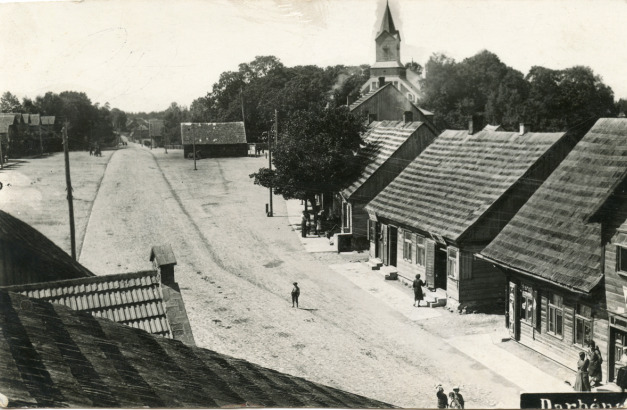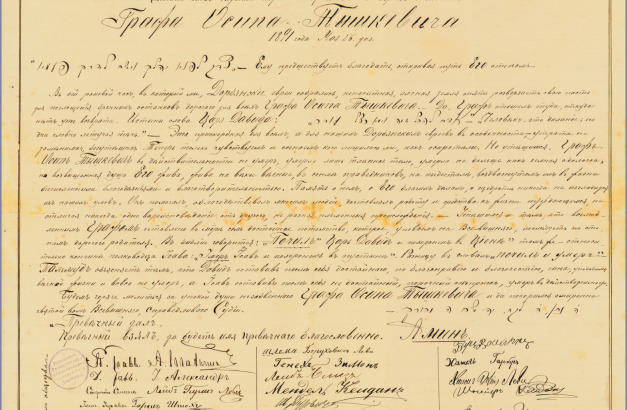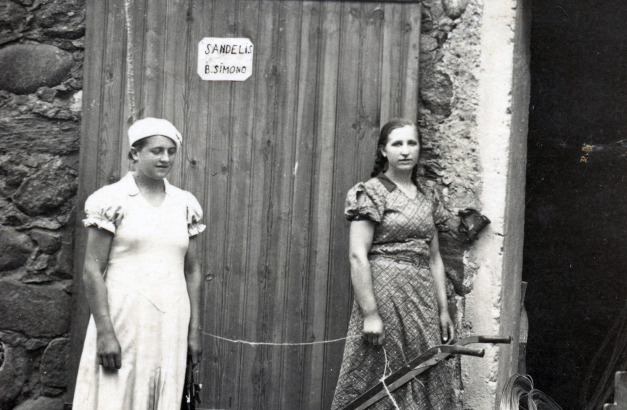Vakarų Lietuvoje esantys Darbėnai pirmą kartą minimi XVI a. pabaigos šaltiniuose, po Lietuvos Didžiosios Kunigaikštystės ūkį pertvarkiusios 1566 m. Valakų reformos. Darbėnų dvaras XVI a. pabaigoje – XVII a. pradžioje priklausė vienam garsiausių visų laikų LDK etmonui Jonui Karoliui Chodkevičiui, kurio valdymo metu Darbėnuose iškilo pirmoji medinė bažnyčia, o pati gyvenvietė įgavo vis daugiau miesteliui būdingų bruožų. Nepaisant daugybės aukų pareikalavusių XVIII a. pradžios karų – Darbėnai amžiaus viduryje sugebėjo atsitiesti, prie to itin prisidėjo žydų bendruomenė.
Manoma, jog žydai Darbėnuose apsigyveno pačiame XVIII a. viduryje. 1764 m. minimi 20 žydams priklausančių namų. Darbėnai formavosi unikalioje vietoje – 7 kelių sankirtoje. Greičiausia tai XIX a. paspartino šio miestelio augimą. Antai 1816 m. miestelio inventoriuje iš viso surašytos 108 sodybos, gyveno 44 žydų šeimos. XIX a. antrojoje pusėje žydai sudarė daugumą miestelio gyventojų: 1868 m. iš 1308 surašytų žmonių – net 738 įvardijami kaip judėjų tikėjimo. Miestelis garsėjo jame vykusiomis mugėmis, kuriose daugiausia buvo prekiaujama arkliais, galvijais, linais ir sėmenimis. Amžiaus pabaigoje miestelis išgyveno savo aukso amžių - jame gyveno kiek daugiau nei 2 000 gyventojų, pusė jų – žydai. Miestelyje kūrėsi naujos įstaigos: paštas, vaistinė, prieglaudos, mokyklos. I-ojo pasaulinio karo metu miestelis ir jo gyventojai nukentėjo, tačiau skirtingai nei daugumai Lietuvos žydų bendruomenių – Darbėnų žydams pavyko išvengti tremties į Rusijos gilumą. Nepaisant to, pirmaisiais XX a. dešimtmečiais dalis Darbėnų žydų išvyko į didesnius miestus, kiti – emigravo į JAV, PAR ir tuometinę Palestiną.
Jau XVIII a. antrojoje pusėje Darbėnuose stovėjo sinagoga, didžioji dalis žydų prekybininkų ir amatininkų gyveno prie turgaus aikštės, Skuodo ir Vaneikių gatvėse. Iki pat XX a. pradžios daugumos Darbėnų žydų pastatai buvo vienaaukščiai, pastatyti iš medžio, į gatvės pusę atgręžtais fasadais, kurių pirmuosiuose aukštuose įprastai veikdavo jiems priklausančios krautuvės bei dirbtuvės. Kiek neįprasta, tačiau XVIII a. antrojoje pusėje sinagoga stovėjo pačioje Turgaus aikštėje priešais bažnyčią. Tikėtina, jog žydų bendruomenei pasistatyti sinagogą šioje vietoje padėjo itin geri santykiai su to meto miestelio savininku. Nepaisant to, XIX a. sudegus sinagogai leidimas ją atstatyti nebuvo suteiktas, o vietos žydai meldėsi kiek atokiau nuo Turgaus aikštės stovėjusiuose maldos namuose.
Miestelio savininko sprendimas leisti žydams įsikurti buvo sąlygotas finansinės naudos – miestelyje gyvenę žydai turėjo mokėti mokesčius didikui. Žinoma, jog XVIII a. antrojoje pusėje žydams buvo išnuomota vietos karčema. Vietos prekyboje iki pat II-pasaulinio karo dominavo žydai, kurių parduotuvėse buvo galima rasti nuo maisto produktų ar kolonialinių prekių iki parfumerijos. Tarpukario metais Darbėnuose garsėjo Bunimo Zimano geležies prekių parduotuvė, kurioje darbo surasdavo ir lietuviai. Žydų tautybės žmonių tarpe galime rasti įvairių specialistų. Štai Abraomas Isachas Pekelis buvo pirmasis profesionalus fotografas Darbėnuose, kuris šio amato išmokė ir savo sūnėną Elijahu Bruckų, kurio dėka mūsų dienas pasiekė daugybė tarpukario Darbėnų ir jo gyventojų nuotraukų. Kiti vertėsi kiek įprastesniais siuvėjo, batsiuvio, mėsininko ar kalvio amatais.
Darbėnuose veikė dvi žydų Talmud Toros ir Tarbut tinklams priklausiusios mokyklos. Miestelyje gimė ir užaugo itin svarbi Izraelio valstybei asmenybių, vienas iš sionizmo judėjimo pradininkų, Teodoro Herclio bendražygis ir antrasis Pasaulinės sionistų organizacijos prezidentas - Davidas Volfsonas (1855-1914), sukūręs Izraelio vėliavą. Tad nenuostabu, jog miestelyje itin populiarios buvo sionizmo idėjos, čia egzistavo dvi atskiros bibliotekos, kuriose buvo kaupiamos knygos jidiš ir hebrajų kalbomis, veikė sionistinės organizacijos, sporto būreliai.
1941 m. birželio mėnesio pabaigoje Darbėnų miestelis pasikeitė visiems laikams. Miestelį užėmusi vokiečių kariuomenė netrukus pradėjo organizuoti vietos žydų žudynes. Birželio 29 d. buvo sušaudyti 150 vyrai. Likusieji - apie 400 moterų ir vaikų padedant vietos kolaborantams buvo nužudyti tų pačių metų rugsėjo mėnesį.
Darbėnai (Dorbyan, דאָרביאַן)
Darbėnai in western Lithuania is first mentioned in sources from the late 16th century, after the reform of the Wallachian Reform of 1566, which reorganised the economy of the Grand Duchy of Lithuania. In the late 16th and early 17th centuries, Darbėnai Manor belonged to one of the most famous Land of Lithuania etmony of all time, Jonas Karolis Chodkevičius, during whose reign the first wooden church was built in Darbėnai, and the settlement itself took on more and more of the characteristics of a town. Despite the wars of the early 18th century, which caused many casualties, Darbėnai managed to recover in the middle of the century, thanks in particular to the Jewish community.
It is believed that Jews settled in Darbėnai in the middle of the 18th century. In 1764, 20 houses belonging to Jews are mentioned. Darbėnai was formed in a unique location - at the intersection of 7 roads. This is probably what accelerated the growth of the town in the 19th century. For example, in 1816, the town's inventory lists a total of 108 homesteads, with 44 Jewish families living there. In the second half of the 19th century, Jews made up the majority of the town's population: in 1868, out of the 1 308 people listed in the census, as many as 738 were of the Jewish faith. The town was famous for its fairs, which were mainly devoted to horses, cattle, flax and linseed. By the end of the century, the town was in its golden age, with just over 2 000 inhabitants, half of them Jewish. New institutions were established in the town: a post office, a pharmacy, shelters and schools. During World War I, the town and its inhabitants suffered, but unlike the majority of Jewish communities in Lithuania, the Jews of Darbėnai managed to avoid deportation to the Russian interior. Nevertheless, in the first decades of the 20th century, some of the Jews of Darbėnai left for larger cities, while others emigrated to the USA, the United States, the United Arab Emirates and what was then Palestine.
Already in the second half of the 18th century there was a synagogue in Darbėnai, and most of the Jewish merchants and craftsmen lived near the market square, on Skuodas and Vaneikiai streets. Until the beginning of the 20th century, most of the Jewish buildings in Darbėnai were single-storey, wooden buildings with facades facing the street, and the ground floors were usually used for their own shops and workshops. Somewhat unusually, in the second half of the 18th century, the synagogue stood right on the Market Square opposite the church. It is likely that the Jewish community's very good relations with the owner of the town at the time helped the synagogue to be built on this site. Nevertheless, when the synagogue burnt down in the 19th century, permission to rebuild it was not granted, and the local Jews worshipped in a house of worship a little further away from Turgaus Square.
The town owner's decision to allow Jews to settle in the town was based on financial gain - the Jews living in the town had to pay taxes to the nobleman. It is known that in the second half of the 18th century a local inn was rented to Jews. Until the Second World War, local trade was dominated by Jews, whose shops ranged from groceries and colonial goods to perfumery. In the interwar years, Darbėnai was famous for Bunim Ziman's ironmongery shop, where Lithuanians could also find work. Among the Jewish population, we can find a variety of professionals. Abraham Issach Pekel was the first professional photographer in Darbėnai, and he taught his nephew Elijah Bruckas the craft, thanks to whom many photographs of Darbėnai and its inhabitants from the interwar period have been taken. Others worked in the more common trades of tailor, shoemaker, butcher or blacksmith.
In Darbėnai, there were two schools belonging to the Jewish Talmud Torah and Tarbut networks. David Wolfson (1855-1914), one of the founders of the Zionist movement, an associate of Theodor Herzl and the second president of the World Zionist Organisation, was born and grew up in the town, where he designed the Israeli flag. It is not surprising, then, that Zionist ideas were very popular in the town, with two separate libraries with books in Yiddish and Hebrew, Zionist organisations and sports clubs.
At the end of June 1941, the town of Darbėnai changed forever. The German army, which had occupied the town, soon began to organise the massacre of local Jews. On 29 June, 150 men were shot. The remaining 400 women and children were murdered in September of the same year with the help of local collaborators.


